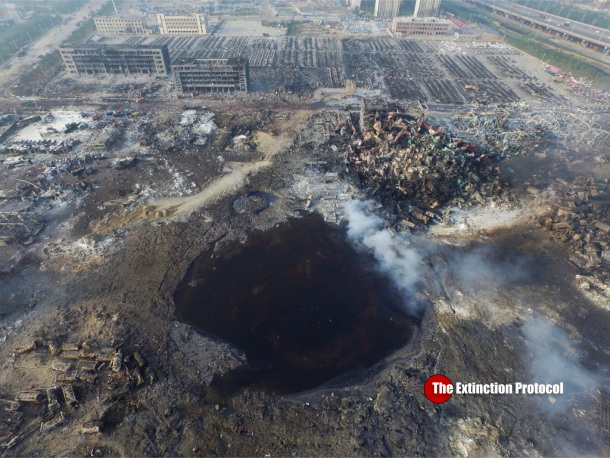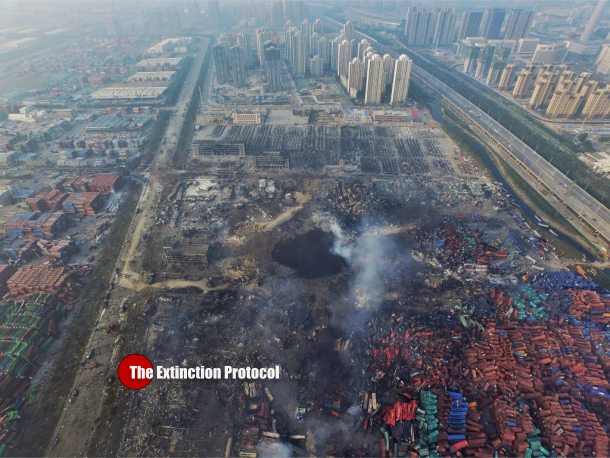Rain
on China blast city raises pollution and contamination fears –
ground water poisoned from massive blast crater?
17
August, 2015
August 2015 – CHINA – Heavy rain fell Tuesday on the remains of a Chinese industrial site devastated by giant explosions, complicating clean-up efforts and heightening fears about toxic contamination as ceremonies were held to mark the disaster’s 114 deaths. Around 700 tons of highly toxic sodium cyanide were at the site in the northern port of Tianjin, officials say, and water could spread it more widely. Rainwater could also disperse chemical residues on the ground into the air when it evaporates, and some of the many substances on the scene could react with it. Amid public anger over the disaster more details about the site operator were reported and a senior work safety official was put under investigation. Officials have insisted the city’s air and water are safe, but locals and victims’ relatives have voiced skepticism, while international environment group Greenpeace has also urged transparency. “I’m worried because we don’t know what’s in the rain,” said a taxi driver as he made his way through the morning deluge. “It could be full of poison.”
Out of 40 water testing points, eight showed excess levels of cyanide on Monday, all within a cordoned-off area surrounding the site of the blasts. The highest reading was 28.4 times official standards, said Bao Jingling, chief engineer at the Tianjin environmental protection bureau. The chemical had been detected at another 21 points and cyanide traces were detected at four other seawater testing points, he added. Authorities have built a dam of sand and earth around the blasts’ central 100,000-square-metre (120,000-square-yard) “core area” to prevent pollutant leakage, Bao said, and drained water from pits and pipelines to make space for the rain. Sodium cyanide, which has a variety of industrial uses including gold mining, is a toxic white crystal or powder. It can release hydrogen cyanide gas, used in gas chamber executions in the U.S. Acute exposure at lower concentrations can cause weakness, nausea and eye and skin irritation while chronic exposure can affect the cardiovascular and central nervous systems, according to the U.S. Environmental Protection Agency.
“We are paying high attention to the rain forecast for the coming couple of days,” Bao told reporters. “We are making plans for the treatment of tens of thousands of tons of polluted water in the pit in the core area.” The air would be “closely monitored” at 18 testing points, and if excessive levels of cyanide or organic compounds were detected the public would be alerted promptly, he promised. But residents are skeptical. “How can we say that the environment is clear?” asked Chen Xingyao, who lived near the blast site and was protesting outside the hotel where the press conference was being held, to demand government compensation for her ruined apartment. “Also, if only the government will test the environment, nobody can know whether it’s good or not.” Amid public anger over the blast and the handling of the aftermath, Chinese media — which are effectively controlled by the authorities — have pointed blame squarely at local officials and the company involved, rather than at any systemic failings in the Communist-ruled country.
The warehouse owner, Ruihai International Logistics, had a license to handle dangerous chemicals at the time of the blast, but there were questions about its certificates and it had previously operated without one, the official Xinhua news agency reported. A total of 10 executives from the firm, including its chief executive, have been detained by police, reports said. The head of China’s national work safety watchdog, Yang Dongliang — a former vice mayor of Tianjin — has been put under investigation for “suspected severe violation of discipline and the law,” the Communist party’s internal anti-graft watchdog said without giving details. The phrase is normally a euphemism for corruption. According to state broadcaster CCTV, a senior fire brigade official said there had been a total of 3,000 tons of dangerous chemicals on the site, in 40 different categories.
–Economic Times of India
Study
links China air pollution to 1.6 million deaths per year, roughly 17
percent of all deaths in China
18
August, 2014
By Dan Levin
13 August 2015
BEIJING (The New York Times) – Outdoor air pollution contributes to the deaths of an estimated 1.6 million people in China every year, or about 4,400 people a day, according to a newly released scientific paper [pdf].
The paper maps the geographic sources of China’s toxic air and concludes that much of the smog that routinely shrouds Beijing comes from emissions in a distant industrial zone, a finding that may complicate the government’s efforts to clean up the capital city’s air in time for the 2022 Winter Olympics.
The authors are members of Berkeley Earth, a research organization based in Berkeley, Calif., that uses statistical techniques to analyze environmental issues. The paper has been accepted for publication in the peer-reviewed scientific journal PLOS One, according to the organization [cf. Koch-funded study finds 2.5°F warming of land since 1750 is manmade – ‘Solar forcing does not appear to contribute’].
According to the data presented in the paper, about three-eighths of the Chinese population breathe air that would be rated “unhealthy” by United States standards. The most dangerous of the pollutants studied were fine airborne particles less than 2.5 microns in diameter, which can find their way deep into human lungs, be absorbed into the bloodstream and cause a host of health problems, including asthma, strokes, lung cancer and heart attacks.
The organization is well known for a study that reviewed the concerns of people who reject established climate science and found that the rise in global average temperatures has been caused “almost entirely” by human activity.
The researchers used similar statistical methods to assess Chinese air pollution. They analyzed four months’ worth of hourly readings taken at 1,500 ground stations in mainland China, Taiwan, and other places in the region, including South Korea. The group said it was publishing the raw data so other researchers could use it to perform their own studies.
Berkeley Earth’s analysis is consistent with earlier indications that China has not been able to successfully tackle its air pollution problems.
Greenpeace East Asia found in April that, of 360 cities in China, more than 90 percent failed to meet national air quality standards in the first three months of 2015.
The Berkeley Earth paper’s findings present data saying that air pollution contributes to 17 percent of all deaths in the nation each year. [more]
ABSTRACT: China has recently made available hourly air pollution data from over 1500 sites, including airborne particulate matter (PM), SO2, NO2, and O3. We apply Kriging interpolation to four months of data to derive pollution maps for eastern China. Consistent with prior findings, the greatest pollution occurs in the east, but significant levels are widespread across northern and central China and are not limited to major cities or geologic basins. Sources of pollution are widespread, but are particularly intense in a northeast corridor that extends from near Shanghai to north of Beijing. During our analysis period, 92% of the population of China experienced >120 hours of unhealthy air (US EPA standard), and 38% experienced average concentrations that were unhealthy. China’s population-weighted average exposure to PM2.5 was 52 µg/m3. The observed air pollution is calculated to contribute to 1.6 million deaths/year in China [0.7–2.2 million deaths/year at 95% confidence], roughly 17% of all deaths in China.
Tianjin
blasts: eyewitnesses capture explosions on film, then flee – video







No comments:
Post a Comment
Note: only a member of this blog may post a comment.